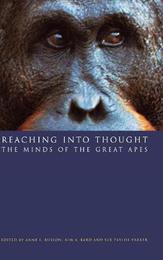
|
Reaching into Thought: The Minds of the Great Apes
Hardback
Main Details
| Title |
Reaching into Thought: The Minds of the Great Apes
|
| Authors and Contributors |
Edited by Anne E. Russon
|
|
Edited by Kim A. Bard
|
|
Edited by Sue Taylor Parker
|
| Physical Properties |
| Format:Hardback | | Pages:478 | | Dimensions(mm): Height 235,Width 159 |
|
| Category/Genre | Animal behaviour
Primates |
|---|
| ISBN/Barcode |
9780521471688
|
| Classifications | Dewey:599.8815 |
|---|
| Audience | | Professional & Vocational | |
|---|
| Illustrations |
23 Tables, unspecified; 41 Halftones, unspecified; 23 Line drawings, unspecified; 23 Tables, unspecified; 41 Halftones, unspecified; 23 Line drawings, unspecified
|
|
Publishing Details |
| Publisher |
Cambridge University Press
|
| Imprint |
Cambridge University Press
|
| Publication Date |
26 July 1996 |
| Publication Country |
United Kingdom
|
Description
What special qualities of mind set the great apes apart from other nonhuman primates, and indeed from ourselves? In this book, field and laboratory researchers show that the great apes have high level abilities in both social and ecological domains, including tool use, pretense, self-awareness, deception, consolation, teaching and culture itself. Great apes are also shown to be capable of thinking at symbolic levels, traditionally considered to be uniquely human. Here, the mechanisms involved in building these abilities - especially the lengthy developmental and 'enculturation' processes - are emphasized, showing how new discoveries are changing views on how primates and human intelligence evolved. This book is for anyone interested in current research and theoretical views of great ape cognition.
Reviews'... excellent chapters ... based on both captive and field experiments.' Craig B. Stanford, The Quarterly Review of Biology 'Recommended for any researcher interested in the study of great ape cognition, and all college and university libraries.' N. Krusko, Choice 'Reaching into Thought is a useful reference, particularly for readers with a background in the behaviour of apes and/or in the theoretical issues surrounding comparative investigations of intelligence ... nicely produced, with many good illustrations.' Christine M. Fillion, and Dorothy M. Fragaszy, University of Georgia, Athens '... this fine book should be considered mandatory reading for all cognitive archaeologists.' Kathleen Gibson, Cambridge Archaeological Journal 'In addition to containing some truly wonderful individual articles, taken as a whole, it serves an important role by accurately reflecting the present status of cognitive primatology as it pertains to Great Apes.' Debbie Custance, Primate Eye ' ... the book taps all the right channels of current interest, every evolutionary cognitive science should buy it and maybe teach a seminar using it.' W. C. McGrew
|